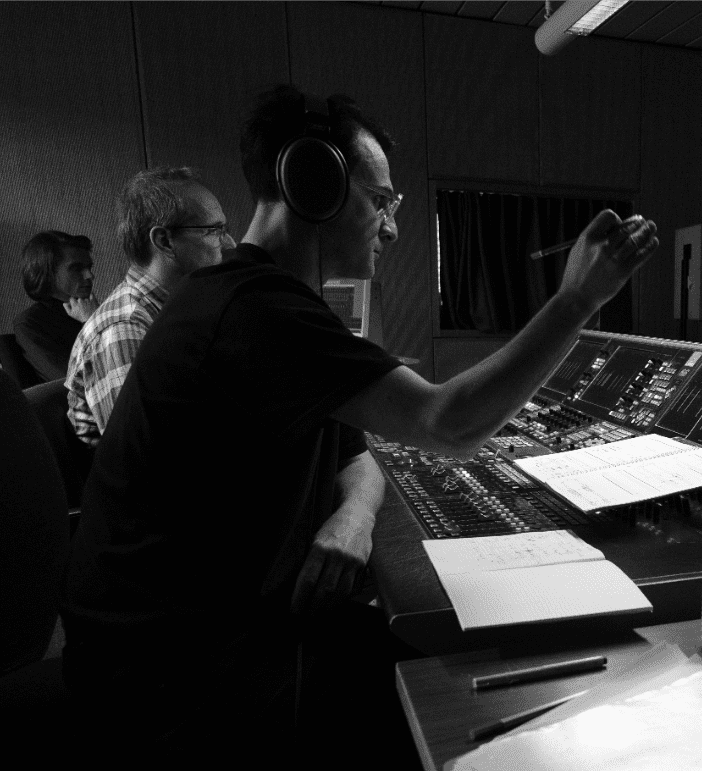for flute, bass clarinet & two pianos for one player (ca. 13’)
Schmelzpunkt is the biological fusion of materials; it is the melting point of acoustic energy. Matter is articulated in tensed fields of extreme registers and with a constant density of opposing phonic weights. Sound expands in acoustic space and acoustic matter is subject to a gradual but constant change in density, timbre and phonic intersection.

Schmelzpunkt – with Anselm Kiefer [2013]


Klangrelief II [2017]
for amplified baritone saxophone (12’)
Klangrelief II is a sound solely based on the defectiveness of timbre. An extremely unstable sound, where the timbre is broken by overexposed tones, a multilayer of extended techniques, dynamic groups and erratic pulses of time. The performance is very physical and a big amount of air pressure is necessary, in order to release the excessive sound, which is in relief towards the audience. Klangrelief means sound relief.

Klangrelief III [2013]
unison duo for amplified contrabass clarinet, amplified baritone saxophone & foot pedals (ca. 21’)
Klangrelief III is an extremely powerful work which embodies two instruments, in parametric differentiation, to accomplish a second unit of sound based on overexposed tones, highly textural developments, multi-simultaneous layers, sound manipulation (foot pedals), and instrumental breakdown.
The overexposure of data releases a crash of intensity, bringing out a global sound in relief: a dense, heavy layer of sources is made to perceive a massive enlargement of sound.

EII – Die schwarze Ausstellung [2018]
for amplified orchestra of 9 instruments & foot pedals (ca. 18’)
Using the term amplified orchestra for nine instruments describes the intention of the composer to extend the proportions and timbre of the ensemble to a HYPER INSTRUMENTUM and to equalize, at the same time, the dynamics and sonic powers of each instrument. Die Schwarze Ausstellung builds up an extreme antithesis on every musical parameter: sound manipulation (foot pedals & amplification) – timbre (overexposed tones & simultaneous multiple extended techniques), dynamics, layering textures, non-linear timing, and the neutralization of rhythm.


E – I [2015]
for amplified cello, 3D projections & amplification (50’)
dark. far. deep vacuum absit verbum nothingness
E I is a place, unknown, into a darker form, a rite of the passage and a profound experience of no-kind, where the language we last saw leaves us speechless to what one has just experienced. Into the depth of an unapologetic and unfiltered soundscape, the listener wanders, where no light has (ever) taken him, and no night ever will. It is in this highly ambiguous and ever shifting environment of broken sound that a calm surrender lays, where once a serenity to what is at present settles the audience deep into now.


M.O.W. [2019]
for augmented cello (11’)
m.o.w. [music of the worms] is yet another, smaller electro-acoustic “burst out” of expanding layers, opposing energies and antithetical relations of sound, a continuation after the solo piece E I, to further explore the different qualities of sound matters of the cello. New synergies are constantly formed, contrasting relations on the musical parameters in terms of time, dynamics and textures, all the while discovering new ways of playing, to enhance the purpose of the performance of releasing a thick and heavy acoustic energy.

Schmelzpunkt – with Anselm Kiefer [2013]
for flute, bass clarinet & two pianos for one player (ca. 13’)
Schmelzpunkt is the biological fusion of materials; it is the melting point of acoustic energy. Matter is articulated in tensed fields of extreme registers and with a constant density of opposing phonic weights. Sound expands in acoustic space and acoustic matter is subject to a gradual but constant change in density, timbre and phonic intersection.

Klangrelief III [2013]
unison duo for amplified contrabass clarinet, amplified baritone saxophone & foot pedals (ca. 21’)
Klangrelief III is an extremely powerful work which embodies two instruments, in parametric differentiation, to accomplish a second unit of sound based on overexposed tones, highly textural developments, multi-simultaneous layers, sound manipulation (foot pedals), and instrumental breakdown.
The overexposure of data releases a crash of intensity, bringing out a global sound in relief: a dense, heavy layer of sources is made to perceive a massive enlargement of sound.


E – I [2015]
for amplified cello, 3D projections & amplification (50’)
dark. far. deep vacuum absit verbum nothingness
E I is a place, unknown, into a darker form, a rite of the passage and a profound experience of no-kind, where the language we last saw leaves us speechless to what one has just experienced. Into the depth of an unapologetic and unfiltered soundscape, the listener wanders, where no light has (ever) taken him, and no night ever will. It is in this highly ambiguous and ever shifting environment of broken sound that a calm surrender lays, where once a serenity to what is at present settles the audience deep into now.


Klangrelief II [2017]
for amplified baritone saxophone (12’)
Klangrelief II is a sound solely based on the defectiveness of timbre. An extremely unstable sound, where the timbre is broken by overexposed tones, a multilayer of extended techniques, dynamic groups and erratic pulses of time. The performance is very physical and a big amount of air pressure is necessary, in order to release the excessive sound, which is in relief towards the audience. Klangrelief means sound relief.

EII – Die schwarze Ausstellung [2018]
for amplified orchestra of 9 instruments & foot pedals (ca. 18’)
Using the term amplified orchestra for nine instruments describes the intention of the composer to extend the proportions and timbre of the ensemble to a HYPER INSTRUMENTUM and to equalize, at the same time, the dynamics and sonic powers of each instrument. Die Schwarze Ausstellung builds up an extreme antithesis on every musical parameter: sound manipulation (foot pedals & amplification) – timbre (overexposed tones & simultaneous multiple extended techniques), dynamics, layering textures, non-linear timing, and the neutralization of rhythm.


M.O.W. [2019]
for augmented cello (11’)
m.o.w. [music of the worms] is yet another, smaller electro-acoustic “burst out” of expanding layers, opposing energies and antithetical relations of sound, a continuation after the solo piece E I, to further explore the different qualities of sound matters of the cello. New synergies are constantly formed, contrasting relations on the musical parameters in terms of time, dynamics and textures, all the while discovering new ways of playing, to enhance the purpose of the performance of releasing a thick and heavy acoustic energy.


